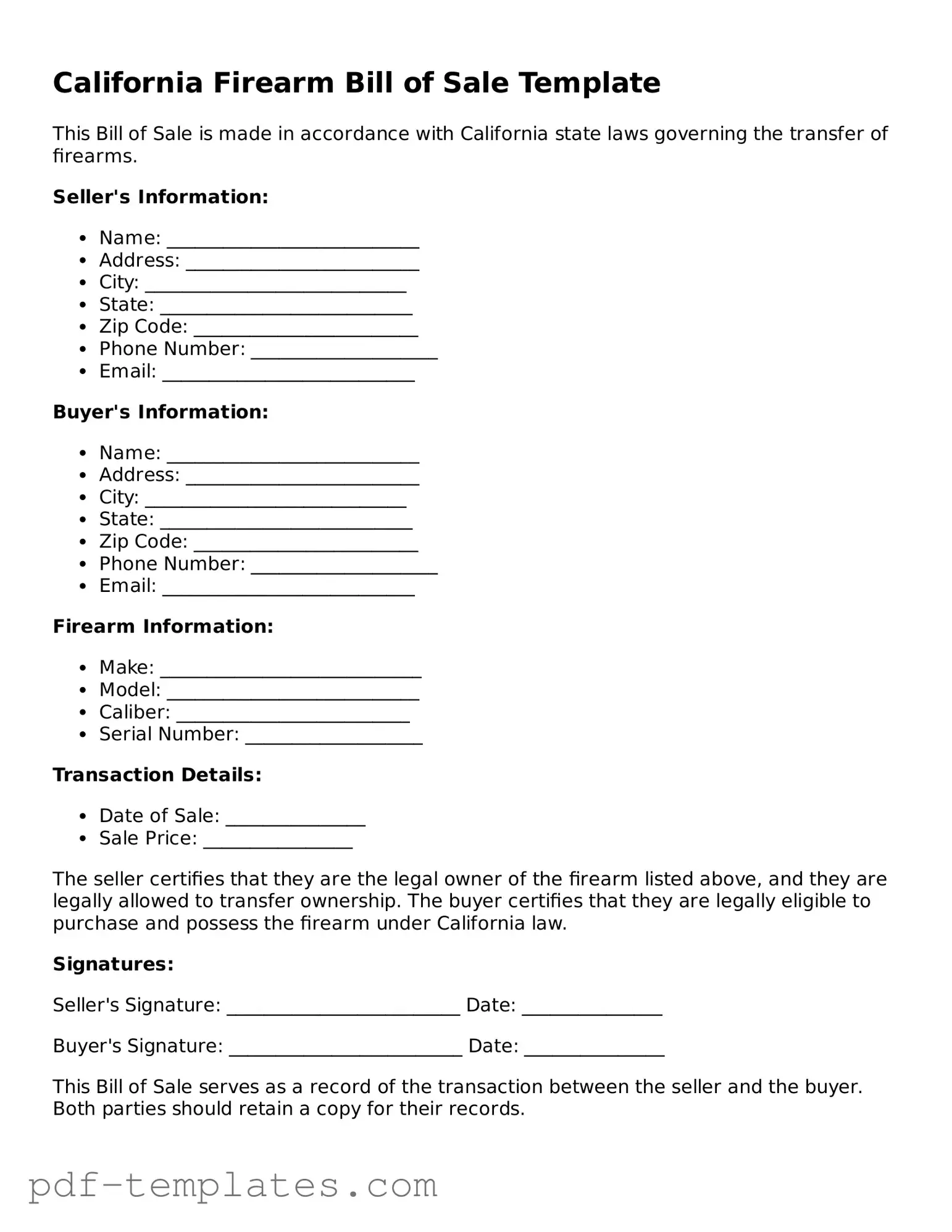The California Firearm Bill of Sale form is similar to a vehicle bill of sale. Both documents serve as proof of transfer for ownership. When a vehicle changes hands, the seller provides a bill of sale to the buyer. This document includes details about the vehicle, such as the make, model, and VIN. Similarly, the firearm bill of sale contains information about the firearm being sold, including its make, model, and serial number. Both documents protect the interests of both parties and are often required for registration purposes.
Another document that resembles the California Firearm Bill of Sale is a real estate purchase agreement. This agreement outlines the terms of a property sale, including the buyer, seller, and property details. Just like the firearm bill of sale, it serves as a legal record of the transaction. Both documents require signatures from both parties to finalize the sale, ensuring that the transfer of ownership is recognized by law.
A lease agreement is also similar in function to the firearm bill of sale. While a lease involves renting property rather than purchasing it, both documents establish a legal relationship between parties. They outline the rights and responsibilities of each party. The firearm bill of sale details the terms of the sale, while a lease agreement specifies the terms of the rental period, payment, and property use. Both documents help clarify expectations and protect the interests of all involved.
The personal property bill of sale is another comparable document. This form is used for the sale of various personal items, such as furniture or electronics. Like the firearm bill of sale, it provides a record of the transaction and includes details about the item being sold. Both documents serve to confirm the transfer of ownership and can be useful in case of disputes over ownership later on.
A pawn ticket is also similar to the firearm bill of sale. When someone pawns an item, they receive a ticket that serves as a receipt and outlines the terms of the transaction. This ticket includes information about the item, just as the firearm bill of sale includes details about the firearm. Both documents establish a temporary transfer of ownership, with the expectation that the item will be returned upon repayment.
The donation receipt is another document that shares similarities with the firearm bill of sale. When someone donates an item, they often receive a receipt that acknowledges the transfer of ownership. This receipt provides details about the item and can be used for tax purposes. In the same way, the firearm bill of sale documents the transfer of a firearm, ensuring that both parties have a record of the transaction.
A contract for the sale of goods is also comparable to the firearm bill of sale. This type of contract outlines the terms under which goods are sold, including price and delivery details. Both documents serve to protect the interests of the buyer and seller. They ensure that both parties agree on the specifics of the transaction, whether it involves a firearm or other goods.
The warranty deed is another document that shares similarities with the firearm bill of sale. While a warranty deed is used in real estate transactions, both documents confirm the transfer of ownership. A warranty deed guarantees that the seller has clear title to the property. Similarly, the firearm bill of sale assures the buyer that the seller has the right to sell the firearm, providing peace of mind to both parties.
The equipment lease agreement is also akin to the firearm bill of sale. This document outlines the terms for leasing equipment, specifying the responsibilities of both parties. While the firearm bill of sale is for ownership transfer, both documents establish a legal framework for the transaction. They ensure clarity and protect the rights of the parties involved.
For those engaging in the purchase of a vehicle in Texas, understanding the nuances of the legal agreements is crucial. A Texas Vehicle Purchase Agreement not only outlines the terms of the sale but also serves to protect both the buyer and the seller from potential disputes. To get started with it, you can find a template at documentonline.org/blank-texas-vehicle-purchase-agreement, which will help clarify the specifics of your transaction, including the price and vehicle details.
Finally, a consignment agreement is similar to the firearm bill of sale in that it outlines the terms of selling an item on behalf of another party. In a consignment, the seller retains ownership until the item is sold. The firearm bill of sale, on the other hand, signifies a complete transfer of ownership. Both documents clarify the relationship between the parties and the expectations for the sale.
